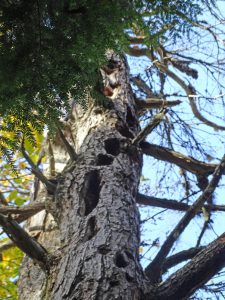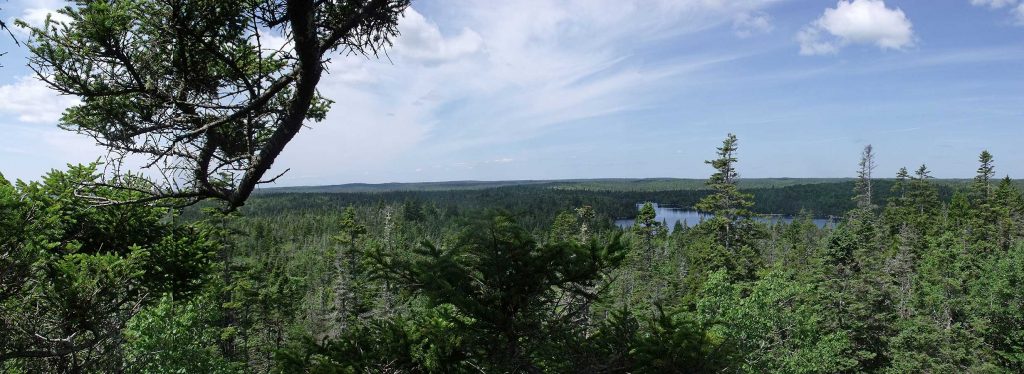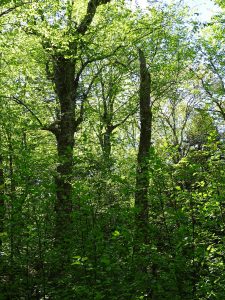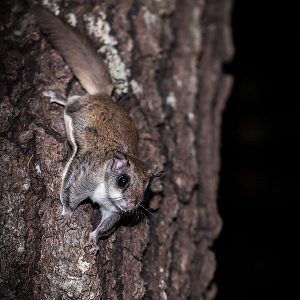
Example of an old forest species: Southern Flying Squirrel (From Wikipedia). We also have the Northern Flying Squirrel in NS. Both species depend on features associated with old forests, including forest stands that don’t currently qualify legally as Old Growth, e.g. at the Dalhousie-Corbett Lakes forest. It appears such stands will not be protected under the proposed Old Growth Forest Policy.
Curiously, in the new policy document , conservation of old forest biodiversity is not explicitly cited in the text as a goal, while it is an explicit goal in the existing (2012) policy. In practice, both the 2012 policy and the proposed policy are weak on conservation of old forest species. Three fixes are suggested: (i) Prohibit logging on all Late Mature and Multi-aged/old forest stands on Crown lands unless they exceed 30% of any 5×5 km square in a 5×5 km grid of NS; (ii) scrap the variable age by Forest Group scheme, and replace it with a minimum age of 100 years; and (iii) scrap the requirement that no forest areas have received a silvicultural treatment or timber harvest within 30 years of the date of approval of this Policy.
The consultation process
A draft “Old-Growth Forest Policy for Nova Scotia” was released on Nov 9, 2021 with a general invitation to Nova Scotians to give their feedback on proposed updates to the policy by Dec 8, 2021 (see NSFN Post, Nov 9, 2021).
It is update to the Old Forest Policy which was published as an “Interim Old Forest Policy” by NSDNR in 1999 and updated as “Nova Scotia’s Old Forest Policy” in 2012.
It’s a pretty technical document and I would guess there are fewer than two dozen people in NS who could really get into it and assess its rigour from an ecological perspective as a policy for protecting Old Growth in NS. There are many more who have a direct interest in the topic and who could be affected by the policy, e.g. through restriction on logging, or through losing a treasured area to Crown land logging.
Unfortunately, it is a rushed process and the consultation is not providing the mechanisms or the time for a full discussion of this important policy, e.g., there are no interactive ‘stakeholder workshops’ such as we saw when the Forest Management Guide was first released and followup drafts that resulted in a final Silvicultural Guide for the Ecological Matrix (SGEM) released in July 2021. While there are still some issues with that guide, there is broad support for it from different constituencies.
The other priority Ecological Project that has been better vetted – but is still not completed and could use more consultation before being implemented- is High Production Forestry.
It is really these 3 projects – the Silvicultural Guide for the Ecological Matrix, High Production Forestry and the Old Forest Policy (now the Old Growth Forest Policy) that, depending on how they are formulated and applied, will determine if we really do apply the Lahey recommendations in the spirit of Lahey.
I have concluded that protecting ecosystems and biodiversity should not be balanced against other objectives and values as if they were of equal weight or importance to those other objectives or values. Instead, protecting and enhancing ecosystems should be the objective (the outcome) of how we balance environmental, social, and economic objectives and values in practising forestry in Nova Scotia. – Bill Lahey
I have been asked on social media what I think about the Draft Policy. It’s a very technical document and it’s hard to give a quick or simple answer. I am working on a submission in response to the government’s request but it will still be a while coming so I will share some components of it as they develop. I invite comments on my comments. Please make those via the Woods and Waters Nova Scotia Facebook site, M.P. will likely make a post thereabout this post and they could be placed there, or separately at the top of the WWNS Facebook page as a new post, giving a link to this post.
The draft Nova Scotia Old Growth Forest Policy is weak on conservation of old forest species
| “OFP 2012” refers to the 2012 Old Forestry Policy
“OGFP 2021” refers to the Draft Old growth Forestry Policy released on Nov 9, 2021 “OFP Layer” refers to the map showing “all all the forest areas on publicly owned land within the Province that were accounted for in the achievement, early in 2020, of protection of at least 8% of the area of each ecodistrict as old-growth forest area and old-growth restoration opportunities.” It is available as a layer in the NS Provincial Landscape Viewer Once in the Viewer, Select the layer at Forestry>Forestry>Old Forest Policy. It is also available at https://nsgi.novascotia.ca/gdd/ “OG” refers to Old Growth |
These documents are not expansive; they are policy documents and the language is chosen carefully. Likewise, they deserve careful reading. Thus I noted that the goal given in OFP 2012 under section 1.0 Rational is “to maintain old forests and associated biodiversity in the forested landscape”. In OGFP 2021 a change in title is introduced – from “Old Forest Policy” to “Old Growth Forest Policy” – and conservation of old forest biodiversity is not explicitly cited in the text as a goal.
The inclusion or not of this goal is important because habitat or components of habitat for many old forest species can in many cases, be conserved in patches or sweeps of forest that do not meet the criteria for Old Growth under either the 2012 OFP or the 2021 OGFP definition.
Two very notable but not explicitly discussed or rationalized changes in the definition are (i) the substitution in the OGFP 2021 definition of “Forest Groups” for the “climax species” of the OGP 2012 definition, and (ii) no requirement for % of Crown closure in the OGFP 2021 definition. Effectively those changes allow a wider range of sites and species to be legally protected as Old Growth forest which is welcomed. However, if we are being asked to evaluate and potentially support the new policy, it would be appropriate to include the related research and reasoning for these changes, perhaps an an auxiliary document; the Story Map document does not serve this purpose.
Age remains the key criterion, but there is a change from a single age of 125 years (OFP 2012) old to a range of ages (OGFP 2021) going from 10o to 140 years old. Three references and “local knowledge” are cited as rationale in Section 9.2. In attempting to retrieve one of the references – Uhlig et al., 2001 Old Growth Forest Definitions for Ontario, Ontario Ministry of Natural Resources (it’s available free but with a shipping cost, I have not yet received it), I stumbled on a major source of the info: a class project at Dalhousie University supervised by Dr. Peter Duinker: A Critical Evaluation of Old-Growth Forest Definitions in Canada, Peter B. Issekutz. ENVS 4901, March, 2020, posted on Dalspace . It cites Dr. Peter Bush as also contributing to the project. It’s a well written paper, contains much of the justification for the changes and should have been cited, as should other such related research e.g., the Story Map document refers to “progressed old forest research programs through focussing on coastal black spruce, red maple and red oak in old growth conditions”.

This mixed stand by Lower Trout Lake with many features supportive of old forest species (eg. deadwood, super canopy trees) is probably less than 125 years old
Reviewing what I was able to access of the scientific justification for the specific ages did not convince me that the specific ages assigned to each Forest Group/Species Associations or Species (Table 9.2.1 in OGFP 2021) are well justified. I am particularly concerned about the increase in the minimum age from 125 to 140 years for three of the forest groups Tolerant Hardwood, Spruce-Hemlock/hemlock dominant Highland/yellow birch dominant). From my experience looking at a range of old forests, the 140 years of age requirement would exclude many stands over 100 but less than 140 years of age that possess features supportive of many old forest species, e.g. many large snags; even the 125 year minimum age which applies to six Forest Groups would exclude many such stands.
There are many old forest species commonly associated with and benefitting from Old Growth, but it is not age per se– a critical criterion in both policy docs for identifying Old growth – that is required but rather old rotting wood, large old fallen deadwood, or large snags, super-canopy trees/a high degree of canopy closure.*
_______________
* Many examples are cited in the very informative L&F/NRR pamphlet A Field Guide to Forest Biodiversity Stewardship by P Neily & G Parsons, 2019. Refer also to….The living dead: acknowledging life after tree death to stop forest degradation by Simon Thorn et al., in Frontiers in Ecology & Environment 03 September 2020; Declining old-forest species as a legacy of large trees lost by G.M. Jones et al. in Diversity and Distributions 05 December 2017; Environmental drivers of forest biodiversity in temperate mixed forests – A multi-taxon approach by F Tinya et al., in Science of the Total Environment 795 (2021) 148720. And Species dependent on OG (Page on this website)
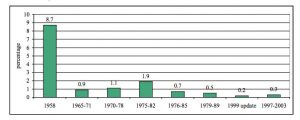
Provincial Forest Area more than 100 years old, Percentage of Total Forest Area, 1958–2003 From GPI Atlantic 2008
Given that true Old Growth, or at least Old Growth as defined by OFP 2012 is extremely limited in NS – circa 0.3% of the forested area and down from circa 8% in the 1950s (view figure at right) one would expect that after protecting existing Old Growth, the next priority would be to conserve as much habitat as possible that contributes to old forest biodiversity. In general that would be forest in the next age category (81-100 years; see figure below) – which will also be the forest which, if protected, will result in the fastest increase in actual OG.
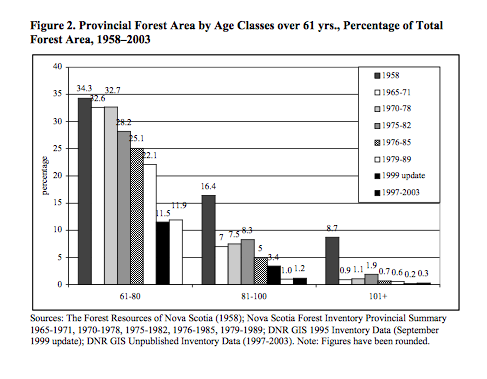
From GPI Atlantic 2008
However, habitat or many components of habitat for such species are not or are much less likely to be found in patches or sweeps of forest in the Old Forest Layer categorized as “old growth restoration opportunities”, a large chunk of which is immature forest.
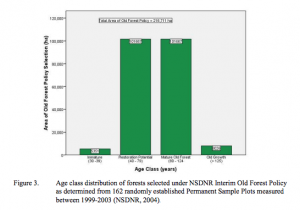
Age classes in the OFP Layer (Fig 3 in Implementation of Nova Scotia Interim Old Forest Policy for Crown Land “A Status Report” Prepared by Bruce Stewart and Peter Neily March 2008) Click on figure to enlarge it.
DNR counts as old forests any stand over 40 years old with a 50 % climax species within protected areas. About 50 % of old forests which DNR counts are 40 -79 year old stands in Protected Areas 2018 – John Leduc, 2019
What happens in practice – under both OFP 2012 and now OGFP 2021 is that the inclusion of these younger forests (all are in existing Protected Areas) in the OFP Layer counts towards the ‘Minimum of 8%’.
If the criteria for “restoration opportunities” took into account the need to find more habitat for old forest biodiversity generally, and to accelerate transition to true old growth, then more suitable habitat would be found in the working Crown lands, much of which will otherwise be harvested, i.e. those opportunities will be lost. Thus it appears at least, that the unstated objective is to retain as much older forest as possible for the sawmills.
What’s the rationale for the 8% target?
In the same vein, it can be asked where does the minimum 8% figure came from?
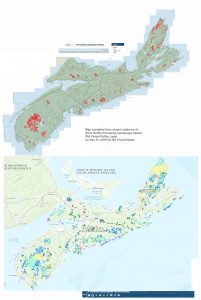
Old Forest Policy Map above and Parks and protected Areas below. Currently approx 400,000 ha forest in the Old Forest Layer are in PPAs and make up about 2% ofPPAs; approx 30,ooo ha are on working Crown lands, or about 4% of those lands. Click on image to enlarge it.
From OGFP 2021 pages 3-4 (bolding inserted)
In 1999, the Government of Nova Scotia published an “Interim Old Forest Policy” (NSDNR, 1999) followed by an update entitled “Nova Scotia’s Old Forest Policy” in 2012 (NSDNR, 2012)in an effort to “maintain old forest and associated biodiversity in the forested landscape”. These policies committed the Province to identify a minimum area of 8% that included old -growth forest and old-growth restoration opportunities on Crown land in each ecodistrict (see Neily et al. (2017) for descriptions of ecodistricts). The identified forest area has both legal (i.e., inside protected areas) and policy (i.e., on Crown land outside protected areas) protection from human activities, including timber harvesting. The protocols for the identification of appropriate areas for policy protection started with old-growth forest areas and the best old-growth restoration opportunities in legally protected areas. Additional forests on the actively managed Crown landbase were then added where protected areas were insufficient.
In early 2020, the 8% minimum target by ecodistrict from the 2012 Old Forest Policy was reached. Currently, there are over four hundred thousand hectares identified in legally protected areas and just over thirty thousand hectares in the remaining Crown land. Over the past 20 years, much of the old forest that was originally identified in non-protected Crown lands through the 1999 Interim Old Forest Policy has subsequently been incorporated into legally protected areas.
There is no reference to scientific literature, no reference to the large body of literature on landscape level processes affecting forest biodiversity (e.g., see Interim Assessment Protocol for Forest Biodiversity in British Columbia, 2020). The approach taken implicitly incorporates some landscape level planning by seeking a minimum of 8% in each ecodistrict, ie., spreading the old forest stands across the whole province which should enhance connectivity but what about relationships between Core areas and Corridors and Stepping Stones,. i.e. the elements of landscape level planning for biodiversity conservation? Where are the maps? There is no discussion or reference in the OFP 2012 or OGFP 2021 documents to landscape level planning for conservation of biodiversity even though the department has devoted considerable resources to and developed many tools for such planning (view https://novascotia.ca/natr/forestry/programs/LandscapePlanning/).
Without such reference, OGFP 2021 conveys a sense that the objective is to conserve some OG stands as in a museum or zoo when what we need is dynamic landscape level planning to conserve old forest biodiversity with OG stands as an increasingly larger component over time.As a backdrop to looking for opportunities for Old Forest restoration, surely the current forest age distribution – or development stage distribution in lieu of that – on private and Crown lands in each ecodistrict is highly relevant in relation to considerations of how much land and which Crown should be placed in the OFP layer for each ecodistrict, but it is not considered.
There is no explicit justification for the “protocol for the identification of appropriate areas for policy protection.. [starting] with old-growth forest areas and the best old-growth restoration opportunities in legally protected areas” …and adding additional areas on the actively managed Crown land base where protected areas are insufficient”.
Such a protocol might be sufficient to conserve Old Growth forest and old forest biodiversity if, for example, 70% of the forested land base were Crown land, but it’s difficult to see it so when Crown land (Provincial and Federal) is circa 35% and we are averse to significantly strengthening protection on private lands through legislation. That leaves more of the onus on the Crown lands, including the working forest to fill this function.
In principle, adoption of Ecological Forestry on the matrix lands will result in more habitat that will contribute to conservation of old forest biodiversity. However, at this juncture in the process of implementing the Lahey Recommendations, we have no details on the assignment of working forest lands to HPF (High Production Forestry) and to the Ecological matrix, which is surely relevant. If HPF is focussed on existing older high volume forests, we could lose many much better ‘restoration opportunities’ than many of those currently in the Old Forest Policy Layer, resulting in a net decline overall in old forest biodiversity on Crown lands! Surely that is not what we want in 2021.
In this context, it is concerning that the OGFP is, or seems to be, placing a limit on the total forest area that is to be conserved in the interest of protecting and increasing OG forest (and hopefully old forest biodiversity more broadly) and are committed only to “ensure no net loss of forest area from the Old Growth Policy Layer” (section 2.2 Objective 3, page 6).
It is hard to rationalize the 8% minimum limit and the inclusion of so much immature forest in the Old Forest Layer except as a deliberate strategy to retain as much older forest on working Crown lands as possible for the sawmills. Clearly that is against the sprit of the Lahey recommendations cited above.

The barred owl requires large trees for nesting. The 2nd Breeding Bird Atlas commented that “there appearred to be some decrease in western NS, potentially because forest harvesting has recently increased in that region.
How to fix it?
I am not very optimistic that NRR is prepared to make the fundamental changes in its OGFP that would be required to make it a policy that is really based on conservation science and reflects the broad desire of Nova Scotians to do more to protect and enhance biodiversity, also to help mitigate climate change. A major downside of a change in tack could be and probably would be more lengthy delays while the department works it all out.
There are in my view, some simple fixes. One fix is to introduce a Precautionary Biodiversity Landscape Plan (BLP) for Nova Scotia in the interim.
What might a Precautionary BLP entail? An example (see NSFN Post, Mar 16, 2020)
(i) Increase the width of watercourse protection zones to fulfill buffer and connectivity functions as cited by Prof Beazley, ideally on all lands in NS, at a minimum on all Crown lands, those, for example could be 150 m where 20 m is now stated.
(ii) Prohibit logging on all Late Mature and Multi-aged/old forest stands on Crown lands unless they exceed 30% of any 5×5 km square in a 5×5 km grid of NS.
A Precautionary Plan does not have to be perfect. It is an interim plan to put in place in an emergency situation – in this case, ongoing precipitous loss of habitat for old forest species – while we figure out a more precise plan. Such provisions, or more appropriately designed precautionary Biodiversity Landscape Planning measures, would remain in place until a full blown BLP is produced. (I offer the above not as specific suggestions, but rather as examples of the approach.)
We already have the relevant databases and maps. Besides protecting more habitat for old forest species and accelerating the development of true Old Growth, such a course of action would also increase carbon sequestration and other ecological services such as flood control and outdoor recreation.
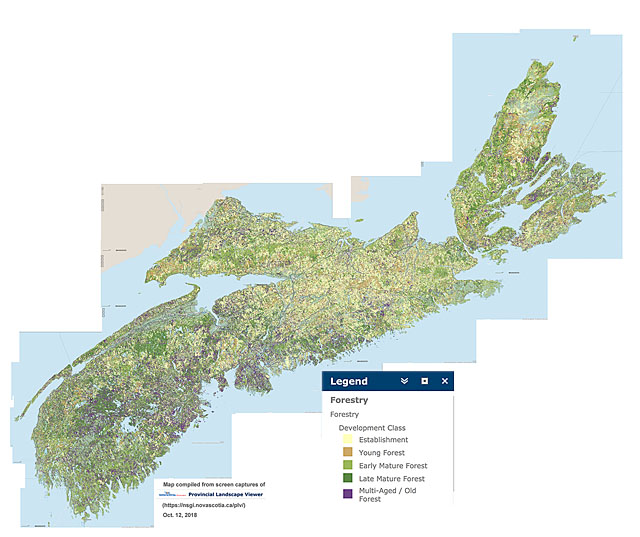
Distribution of forest in 5 development stages across Nova Scotia, compiled from NS Landscape Map Viewer. Purple = Multi-aged/Old Forest. View larger versions of the map: 2000 px | 4000 px.
(You may have to Save the larger image and open it on your device to view at full size).
A second fix is to scrap the variable age by Forest Group scheme, and replace it with a minimum age of 100 years. Such a move is justified by the literature cited in OGFP 2021, and would retain a lauded virtue of the 2021 definition: a clear, simple and operational definition of Old Growth. It would also allow legal protection of much more land that has value for conservation of old forest species. Scrapping the variable ages would also mean the categorization by Forest Groups could be scrapped, making it all much simpler.
A third fix is to scrap the requirement cited on p 8 of OGFP 2021 that “no forest areas that have received a silvicultural treatment or timber harvest within 30 years of the date of approval of this Policy will be designated to be protected, provided there is documentation of the treatment.”
It’s difficult to ascertain any scientific justification for that criterion. A partially harvested stand that still retains significant patches of Old Growth, snags etc. is still valuable for old forest species – they are not going to discriminate. It’s hard to see this restriction as anything other than a way of retaining more old forest – especially old forest that has been partially harvested subsequent to the Lahey report of Aug 2018 – for the cutting block.
Inevitably, such actions would come up against strong resistance from Big Forestry as pretty well, Late Mature and Multi-aged/old forest stands are also the highest volume stands, and those are the stands most sought after by the sawmills in Covid and probably post-covid times.
Big Forestry has access to the more abundant private forest lands and has successfully fought any legislation that would increase legal protections of Biodiversity on those lands – re, the Biodiversity Act controversies of this past year. Surely that puts more onus on our government to priorize biodiversity conservation on the Crown lands. Broadly that’s what Nova Scotians want and its what prof Lahey wants.
At the very least we need to be presented with much clearer facts about the state of Old Growth and old forest biodiversity in NS than has been presented in the draft OGFP 2021 and in related documents such as the Story Map; and we need to see scientific justification for any proposed policy, also seriously lacking in the current document.
Some related News items and Posts and Pages on NS Forest Notes
– “Finding the Mother Tree” – can it change the way we manage our forests in Nova Scotia? 9May2021?
Posted on NSFN May 9, 2021
– Lahey forestry report author issues scathing update on lack of progress after 3 years
Michael Gorman · CBC News Nov 30, 2021. “William Lahey concludes Department of Natural Resources has yet to fully embrace ecological forestry…The department needs to “fully embrace transparency and accountability as standard operating procedure and as a culture,” Lahey writes. “It is not clear that the department has embraced the ecological paradigm called for in the [report]. Instead, it appears to be still operating within a paradigm in which forest production and ecological systems are regarded as values to be balanced against one another, with the balance in favour of the former where the two come into essential conflict.””
– Scott Leslie’s “backgrounder” video on the Corbett-Lake Old Growth Forest, Little Brown Bat added to SAR residents 17July 2019
Post on NSFN July 17, 2019 “After viewing Scott Leslie’s Video, I had one big question: What DOES it take for a site to be protected as Old Growth in Nova Scotia?”
– Annapolis Co. group finds fresh stump of 138 yr old tree in Corbett-Dalhousie Lakes Forest, but it’s not Old Growth says L&F 6May2019
Posted on NSFN May 6, 2019
– N.S. drafts updated old-growth forest policy, advocates say it doesn’t go far enough
Taryn Grant · CBC News. Nov 9, 2021 “”They made the house a little prettier and tidier. But the foundation is still cracked and significant progress, I think, is still lacking.” – Alain Belliveau”
– Critics say a new government policy won’t do much to save old forests in N.S. (audio)
CBC Info AMNov 17, 2021. “Forestry, farming and development have taken a toll on old forests in Nova Scotia. Now a new government policy is aimed at preserving what remains. But some say it’s not enough. We hear from Mike Lancaster, coordinator of Nova Scotia’s Healthy Forest Coalition.”
– What is Old Growth?
Section on this website
– Nova Scotia DNR almost admits serious errors; Port Hawkesbury Paper blames DNR for Loon Lake area cuts of Old Growth
Posted on NSFN March 15, 2018
– Nova Scotia NRR: “DYK the Old Forest Policy protects the oldest tree in the Maritimes?” 15Nov2021
Posted on NSFN November 15, 2021
– Thanks for sensitive management of an old forest in Nova Scotia
Posted on NSFN October 8, 2018
– Landscape-level “Log the best and leave the rest” on Nova Scotia’s Crown land forests 10Jan 2021
Posted on NSFN January 10, 2021 “Examples from the two most recent Harvest Plan Notifications, one in Queens Co. in SW Nova Scotia and one in the area of the proposed Ingram River Wilderness Area (Halifax Co.) illustrate how the practice of “log the best and leave the rest” (high-grading) continues to operate at a landscape scale on Nova Scotia’s Crown lands, the Lahey Recommendations (2018) and those of the Natural Resources Strategy (2010) notwithstanding.”

